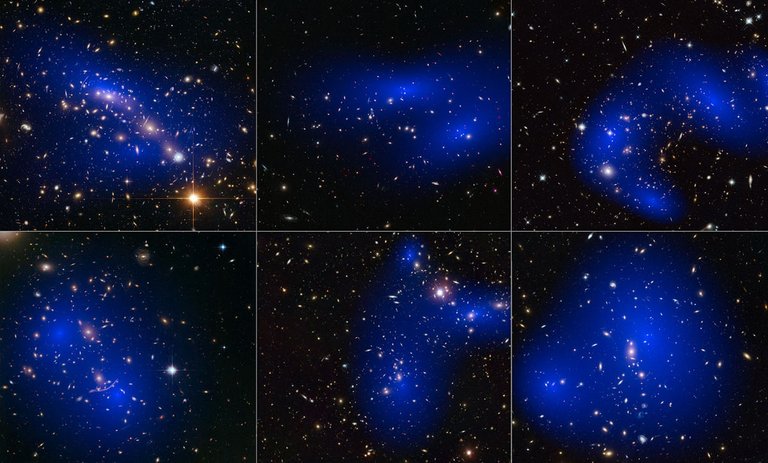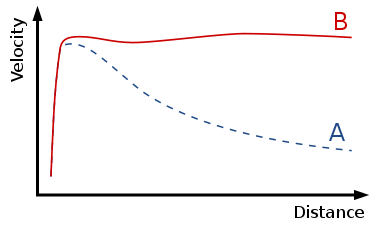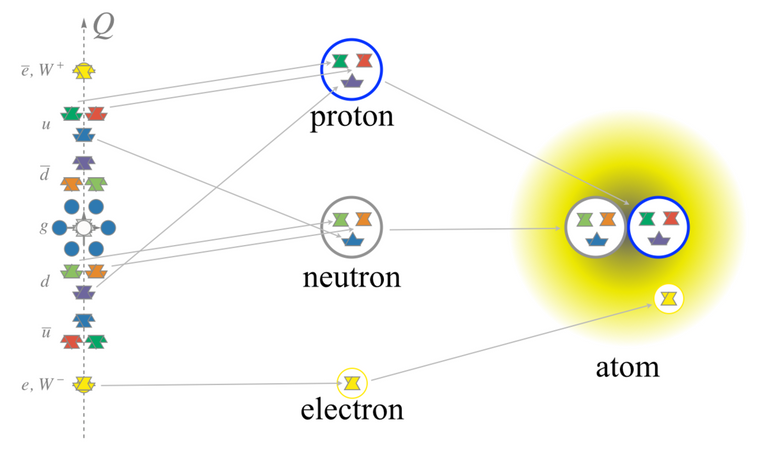Have you ever heard that our universe is actually dark? All familiar objects that we can see like planets, stars, galaxies, etc. it turns out to constitute only a fraction of the total matter in the universe. The rest is material that is not visible. Astronomers call this invisible material a dark matter.

Missing Mass Problems
All the things we can see around us, from our bodies, the planet Earth we are treading on, and the stars in the sky, they are all made of atoms. Atoms themselves are composed of smaller particles such as protons, neutrons, and electrons. Even the particles are composed of much smaller sub-particles.
When scientists began to understand what constituted atoms in the early 20th century, they felt they had understood the basis of all matter in the universe. However, in 1933, a Swiss astronomer named Fritz Zwicky began to argue that the universe should also be filled by something else, not just the atoms we know today. Zwicky counts all the material seen in the cluster of galaxies. He found that the amount of matter seen was not enough to produce a force of gravity that could keep these galaxies clustered into a cluster of galaxies. The galaxies observed by Zwicky also rotate too fast so they should be scattered among themselves. Zwicky realized that there should be something else capable of generating great gravity so that the galaxies remain intact. He called the material an unseen dark matter.
In his time, Zwicky was regarded as an eccentric person so his theory was not taken seriously by other astronomers. They assume that Zwicky created a new form of a matter because the force of gravity he calculated did not match the observations. Zwicky's research was forgotten by many people until in the late 1970s an astronomer named Vera Rubin discovered a strange rotational galaxy.

Weirdness at the orbital speed of the stars in the galaxy. commons.wikimedia
In the Solar System, we know that the law of gravity is simple. The farther away a planet is from the Sun, the gravity perceived by the planet is getting weaker. Thus, the planet will revolve around the Sun (evolved) at a slower rate. Should the same law apply to stars orbiting the galactic center? Stars that are farther away from the center of the galaxy should move more slowly due to the weaker influence of gravity. Surprisingly, Rubin discovered that the stars in the more outer parts of the galaxy move at speeds that are not much different from the stars in the deeper parts of the galaxy. There is something that keeps the stars still orbiting rapidly and not coming out of the galaxy. Rubin realizes that Zwicky's theory is right.
Searching of Dark Matter
Currently, astronomers believe that dark matter is a fundamental material in shaping the universe that we know. At 13.7 billion years ago, the moment when the Big Bang took place, the universe was created and expands very quickly along with the clusters of galaxies that are beginning to form. However, the universe did not expand so quickly that the galaxies did not escape into the corners of the universe. This is because dark matter keeps the galaxies intact. Although not visible, dark matter plays an important role in the formation of galaxy clusters that we can currently see.
Dark matter is like wind, we can not see it directly, but we are sure that it exists. Even more amazing is the dark matter fills about 24% of our universe. Astronomers believe that 28.6% of our universe is filled with matter. As already mentioned, 24% is dark matter while 4.6% is normal matter (atoms we know). About 71.4% of our universe is filled by something called dark energy.
In the 1980s, the first evidence of a relatively convincing existence of dark matter was discovered. For example, in 1981 a team led by Marc Davis of Harvard University conducted a survey of galaxy surveys. They realize that the galaxies do not lie in a uniform pattern in the universe. The galaxies tend to cluster together and form large galaxy clusters. This collection pattern is called the cosmic web. This network is tied to the dark matter. In other words, dark matter is the frame where normal matter is attached.
The discovery of cosmic networks has prompted astronomers to find out why galaxy clusters are forming such a pattern. Furthermore, they also examine what particles are actually dark matter. In 1980, a team from Russia led by V.A. Lyubimov proposed that dark matter is actually a particle called a neutrino. Neutrino has a nickname as a "ghost particle" because it barely interacts with other particles. Lyubimov argues that if the entire mass of the neutrino is summed, then its mass will be equal to all the dark matter mass in the universe. Unfortunately there is one problem, namely, a neutrino is a hot dark matter which means the particle is light and move very fast. The astronomer named Carlos Frenk then tried to make a simulation of the formation of the universe that contains dark matter. The surprising thing is that if the universe is filled with hot dark matter, then the cosmic form of the network looks not the same as the one we observe today. The universe that is formed is completely different from what it should be. Therefore, the theory emerged that dark matter should be cold and move slowly. The next step is to find out what particles are like that.

A dark matter map that forms a cosmic network. ccwikipedia
Although dark matter is not visible directly, dark matter can still be detected by its gravity. Even the light passing around the dark matter will be deflected. This effect is referred to as gravitational lensing (gravitational lensing). Gravitational lensing can be used to find places that contain dark matter. This technique is used by astronomers to create dark matter maps in the universe. Until now, they can only map a small fraction of the universe. However, they have high ambitions and hope to create a dark matter map that covers an eighth of the size of the universe. The size of it is equal to the space filled with millions of galaxies
As time passes, some ideas about dark matter are proposed. One popular idea is that dark matter is a new type of particle called the WIMPs (Weak Interacting Massive Particles). According to Anne Green from the University of Nottingham, WIMPs barely interact with normal matter. For example, if WIMPs hit a wall, WIMPs will pass through without causing a collision. WIMPs have a large mass, perhaps around the mass of hundreds or thousands of protons. Unfortunately, we still do not know what exactly WIMPs are. WIMPs are just a term, whereas the particles may consist of different types of particles. The bad news is that WIMPs are very difficult to detect. Maybe it sounds crazy to you. First, astronomers find dark matter that can not be seen directly. Then, they now propose very difficult particles to detect to explain it. Yes, you are not the first to comment like that.
The notion of what exactly dark matter does not always involve a mysterious particle to explain it. In 1983, some scientists argued that dark matter actually does not exist. What's wrong is the law of gravity that we know today that galaxies seem to be weird. They developed a new theory of gravity called "Modified Newtonian Dynamics" or abbreviated as MOND. Although popular, currently MOND has not been able to explain the observed data well.
Detecting Dark Matter

"Bullet Cluster" are two clusters of galaxies that are colliding and provide strong evidence of the existence of dark matter. commons.wikimedia
In 2006, NASA published a spectacular image that made MOND supporters lost badly. The image shows two clusters of galaxies that are colliding. Normal matter is clearly visible in the middle and in this part we expect almost the entire mass and gravity to be. However, on the outside, there is a deflection of light by gravity indicating that there is still considerable gravity in the area. This image is a direct proof of the existence of dark matter. If this is true, then the challenge we face back to the beginning. We have to look for dark matter, whereas we do not know what we are looking for.
Although difficult, there are three different ways to answer the challenge. The first is to observe the dark matter that is interacting in the universe. This is done by monitoring the dark matter behavior using an existing map and looking for a collision event. The dark matter particles usually pass by when they collide with normal matter. However, it is hoped that there will be some dark matter that hit the atomic nucleus. When this happens, dark matter will "kick" and catapult the atomic nucleus. This collision will produce gamma rays: light with very high energy, and as if the dark matter is "shining". By 2014, using NASA's Fermi telescope data, some astronomers claim they have discovered a gamma ray from a dark matter collision occurring somewhere in the Milky Way galaxy. However, such gamma rays may be generated by other sources such as energetic stars called pulsars or from collapsing stars. Another observation is to observe dark matter that collides with the fellow dark matter. Richard Massey of Durham University and his team a few years ago monitored interactional collisions. They originally hoped that all the dark matter in the galaxy was not affected by the collision and escaped just like that. Apparently, they even found some of the dark matter left from the galaxy of the parent when the collision occurred. This indicates the interaction between dark matter.
The second way to detect dark matter is to create it. Scientists hope by using tools such as the Large Hadron Collider (LHC) in Switzerland they can make dark matter. LHC can crush protons at high speed (near the speed of light). This collision is strong enough to destroy protons into smaller parts. The LHC can study the proton's components. At times of high-energy collisions, new particles such as WIMPs may be found. If dark matter is WIMPs, then LHC has a great chance to find it. However, if dark matter is not WIMPs, LHC will never be able to find it.
The third way is to create a laboratory underground. Scientists hope to be able to detect the WIMPs that collide with normal matter. Billions of dark matter particles pass through our bodies every second. They are everywhere. Theoretically, we should be able to detect the gamma rays generated from the collision between dark matter and normal matter. The problem is that the cosmic ray radiation received at the Earth's surface may interfere with the detection of dark matter. Therefore we have to build a laboratory underground. So far no convincing results have been obtained. Some laboratories claim to find something, but after further investigation it is not WIMPs.
For now, our knowledge of the universe is still dark. Astronomers hope to find an answer about dark matter in the next few decades. Although it has been almost a century since Zwicky proposed the existence of dark matter until now we still do not know the real form of dark matter. It is a reminder to us that there is still much to be learned to understand the universe. There are still many secrets of the universe that we need to uncover.
Reference :
- http://www.bbc.com/earth/story/20150824-what-is-the-universe-made-of
- http://iopscience.iop.org/book/978-0-7503-1373-5/chapter/bk978-0-7503-1373-5ch1
- http://www.cfhtlens.org/public/what-gravitational-lensing
- https://science.nasa.gov/astrophysics/focus-areas/what-is-dark-energy
- https://www.nationalgeographic.com/science/space/dark-matter/
- http://www.dailymail.co.uk/sciencetech/article-3586781/Is-dark-matter-changing-stripes-Mysterious-invisible-material-slowed-expansion-universe.html



Well written whalhesa, enjoyed reading and learnt a lot from your article, it intrigued me the way many tried to explain them, the theories and all, I just hope that someday we find a suitable explanation and prove for dark matter.
Thanks for sharing.
You are welcome @logic42
Good writing. I loved reading your article.
thanks @rifkan
:)
That was the same way they killed all those that said the earth is round, because the common mind thought it is flat. True facts will surely surface from the waters of fallacy. Nicely written @whalhesa
the truth must win. just waiting for the process, because gold cannot be obtained easily
thanks @whileponderin
Nice and interesting read. I learned a lot from this article. Great job!
thanks @stem-explorers for visited me.....
:)
Splendid. Excellent writing. Superb job brother @whalhesa
thanks brother @alzamna
:)
I've read whole article and I haven't regret, it's really good! :)